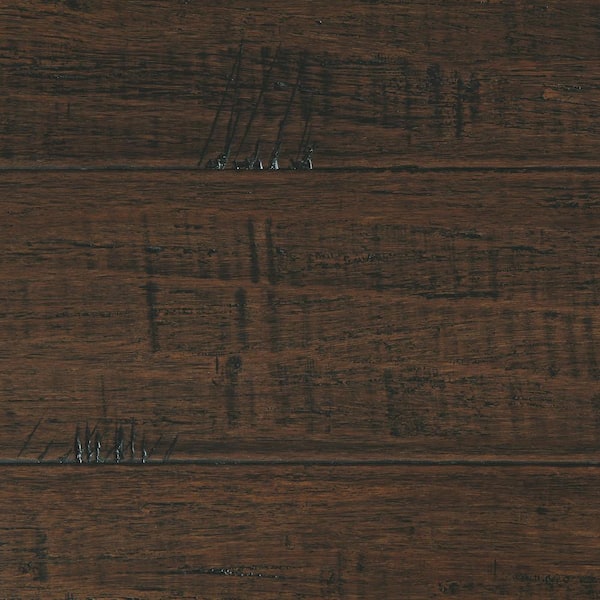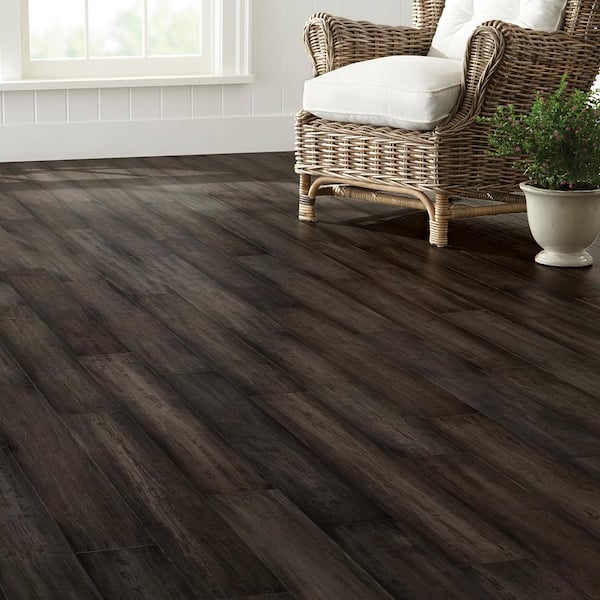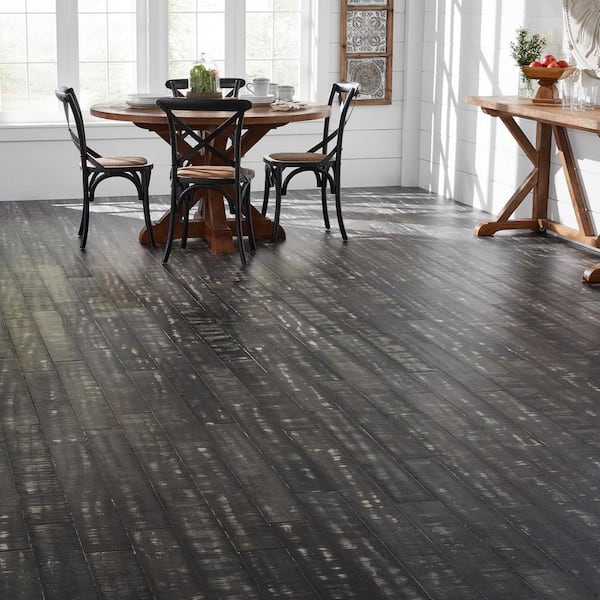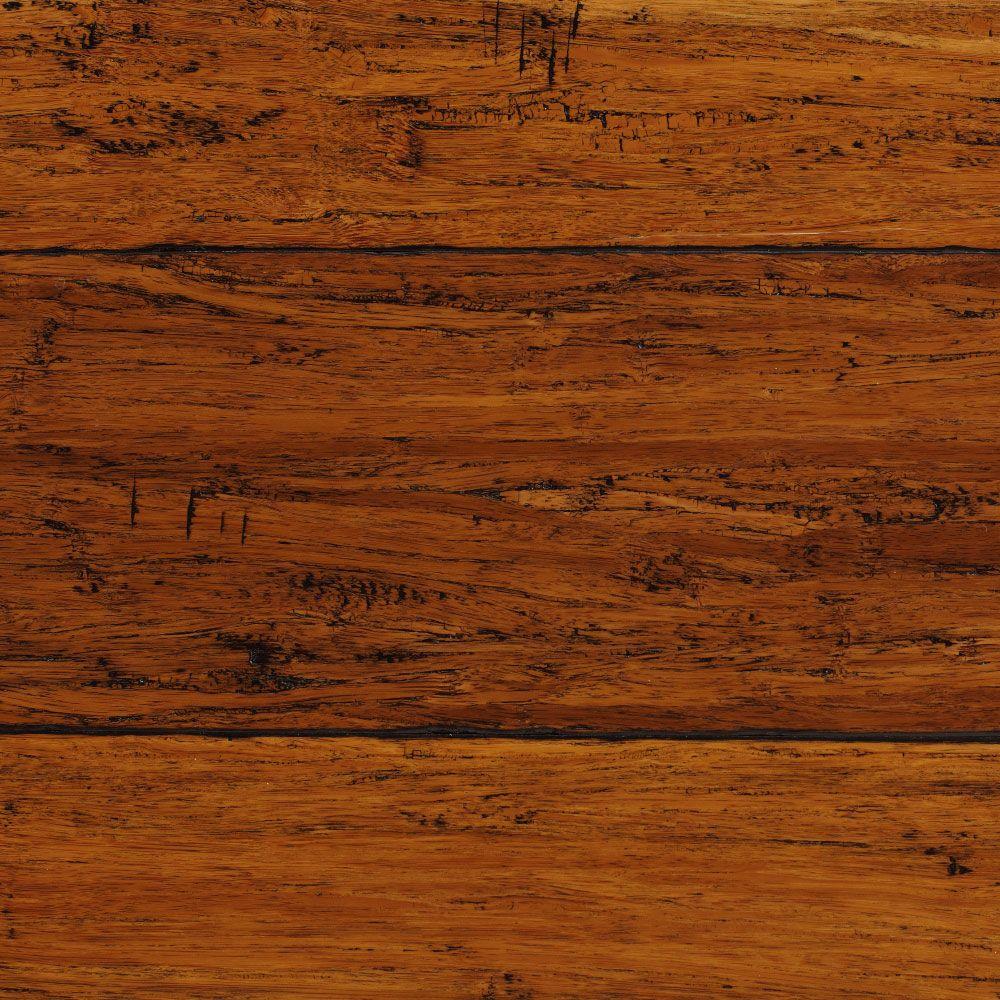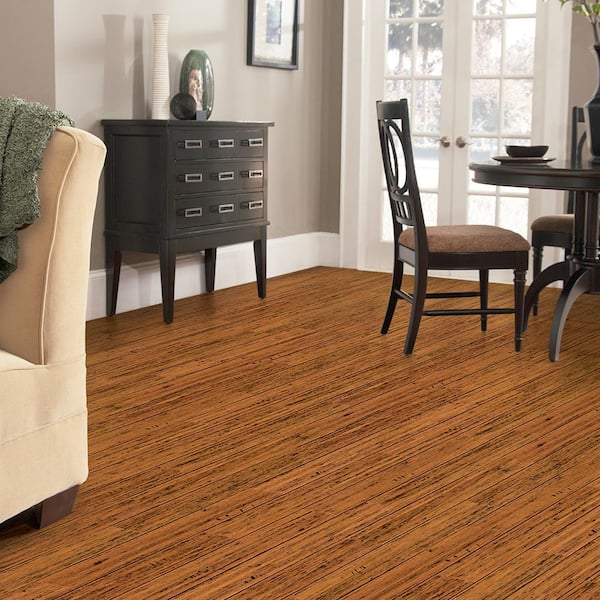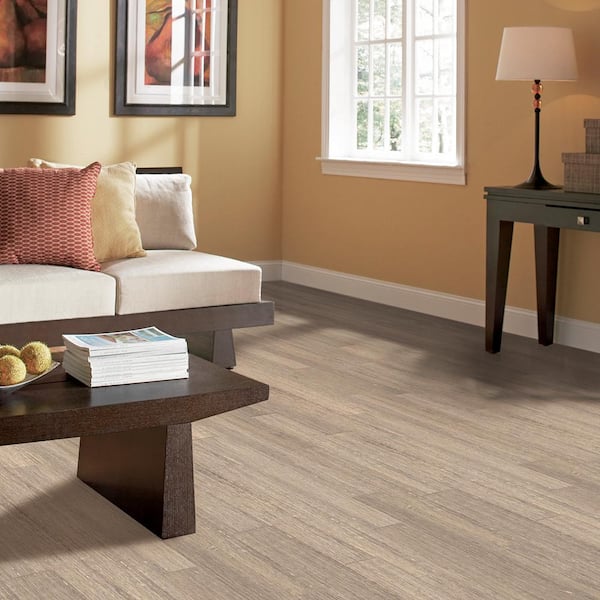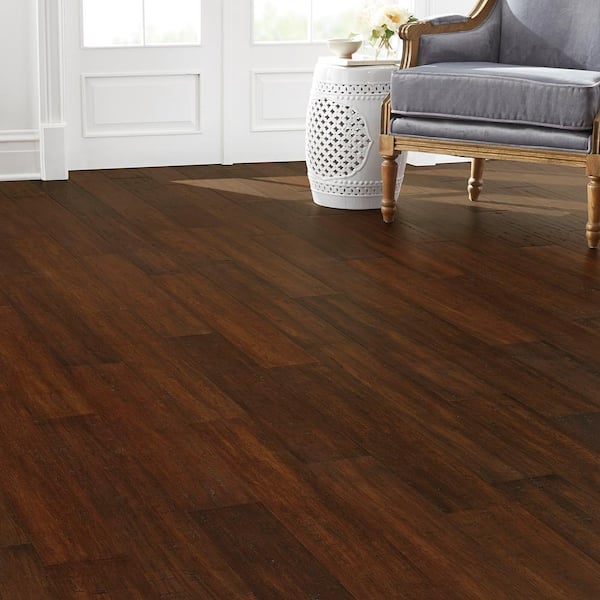Hand-scraped strand woven bamboo flooring combines aesthetic appeal with environmental responsibility, making it a popular choice among homeowners. In today’s post, we will explore the characteristics, benefits, and considerations of this flooring option, helping you make an informed decision for your home.
Understanding Hand-Scraped Strand Woven Bamboo Flooring
What is Hand-Scraped Strand Woven Bamboo Flooring?
Hand-scraped strand woven bamboo flooring is a type of bamboo flooring characterized by its textured surface and enhanced durability. Unlike traditional bamboo flooring, which often has a smooth and uniform finish, hand-scraped bamboo features a unique, handcrafted texture that mimics the look of aged, reclaimed wood.
This flooring is made by weaving together bamboo fibers and compressing them under high pressure. The result is a dense and sturdy material known as strand woven bamboo. The hand-scraped process involves artisans manually scraping the surface to create a textured finish. This not only adds visual interest but also helps to hide scratches and wear, making it a practical choice for high-traffic areas.
Strand woven bamboo is known for its exceptional strength and durability, often outperforming traditional hardwoods in terms of hardness and resistance to wear. The hand-scraped finish further enhances its ability to withstand daily use while adding a touch of rustic charm.
The Manufacturing Process
The manufacturing of hand-scraped strand woven bamboo flooring begins with the harvesting of mature bamboo stalks. These stalks are cut into thin strips, which are then boiled to remove any sugars and starches that could attract pests or cause mold. This boiling process also helps to enhance the color and stability of the bamboo.
After boiling, the bamboo strips are dried and woven together to form a dense mat. This mat is then compressed under high pressure and heat, creating the strand woven bamboo material. The high-pressure compression process is what gives strand woven bamboo its remarkable density and durability, making it much harder than traditional bamboo flooring.
Once the strand woven bamboo material is formed, it is cut into planks and sanded to a smooth finish. The hand-scraping process is then carried out by skilled artisans who use specialized tools to create a textured surface. Each plank is individually scraped, giving the flooring its unique and handcrafted appearance.
Finally, the planks are coated with a protective finish, which can vary depending on the desired look and performance characteristics. Common finishes include polyurethane, which provides a durable and glossy surface, or oil-based finishes that offer a more natural and matte appearance.

Environmental Benefits
Hand-scraped strand woven bamboo flooring is often touted as an eco-friendly alternative to traditional hardwood flooring. Bamboo is a rapidly renewable resource, with some species maturing in as little as three to five years. This makes it a more sustainable option compared to hardwoods, which can take decades to reach maturity.
The manufacturing process also tends to have a lower environmental impact compared to traditional hardwood processing. Bamboo requires fewer pesticides and fertilizers to grow, and the efficient use of bamboo fibers in the strand woven process minimizes waste. Additionally, many manufacturers use adhesives that are free from formaldehyde, reducing the release of harmful volatile organic compounds (VOCs).
The durability and longevity of strand woven bamboo flooring further contribute to its environmental benefits. Its resistance to wear and damage means that it can last for many years, reducing the need for frequent replacements and conserving natural resources.
Aesthetic Appeal
One of the standout features of hand-scraped strand woven bamboo flooring is its aesthetic appeal. The hand-scraped finish provides a unique texture that adds character and visual interest to any room. This textured surface can mimic the look of reclaimed or antique wood, giving the floor a timeless and rustic charm.
The natural variations in bamboo, combined with the hand-scraped process, create a diverse range of patterns and colors. No two planks are exactly alike, resulting in a floor that is both unique and versatile. Whether you prefer a light, natural bamboo look or a darker, more dramatic finish, there are options to suit various design preferences.
In addition to its visual appeal, the hand-scraped texture also provides practical benefits. It helps to camouflage scratches, dents, and wear, making the flooring more forgiving in high-traffic areas. This makes hand-scraped strand woven bamboo an excellent choice for households with children or pets, where durability and appearance are equally important.
Suitability for Different Spaces
Hand-scraped strand woven bamboo flooring is suitable for a wide range of spaces, from residential homes to commercial settings. Its durability and resistance to wear make it an ideal choice for high-traffic areas such as living rooms, hallways, and kitchens. The textured surface provides additional traction, reducing the risk of slips and falls, which can be particularly beneficial in households with young children or elderly residents.
In addition to its practicality, the aesthetic appeal of hand-scraped bamboo flooring makes it a versatile option for various interior design styles. Its rustic charm complements traditional and farmhouse-inspired decor, while its clean lines and natural variations make it suitable for modern and contemporary settings.
For commercial spaces, hand-scraped strand woven bamboo offers a combination of durability and style that can withstand heavy use while creating a welcoming and attractive environment. It is commonly used in retail stores, offices, and hospitality settings where both performance and appearance are essential considerations.
Installation Methods and Considerations
Choosing the Right Installation Method
Hand-scraped strand woven bamboo flooring can be installed using various methods, depending on the subfloor type, room conditions, and personal preferences. The most common installation methods include floating, glue-down, and nail-down installations. Each method has its advantages and considerations, making it important to choose the right approach for your specific situation.
Floating Installation: This method involves laying the bamboo planks over a foam underlayment without attaching them directly to the subfloor. The planks are joined together using a click-lock system, allowing them to “float” above the subfloor. Floating installation is relatively easy and can be done by DIY enthusiasts. It is suitable for various subfloor types, including concrete and plywood, and allows for easy removal and replacement of planks if needed.
Glue-Down Installation: In this method, the bamboo planks are adhered directly to the subfloor using a high-quality adhesive. Glue-down installation provides a stable and secure bond, making it suitable for high-traffic areas and commercial settings. It is essential to use adhesives that are compatible with bamboo flooring and free from harmful VOCs. This method requires careful preparation of the subfloor to ensure a smooth and even surface.
Nail-Down Installation: This traditional method involves nailing the bamboo planks to a wooden subfloor. Nail-down installation provides a strong and permanent bond, making it a suitable choice for areas where additional stability is required. This method is commonly used with hardwood subfloors and can be more labor-intensive compared to floating or glue-down installations. Proper tools and techniques are essential to avoid damaging the planks during installation.
Preparing the Subfloor
Proper subfloor preparation is crucial for a successful installation of hand-scraped strand woven bamboo flooring. The subfloor must be clean, dry, and level to ensure a smooth and stable surface for the bamboo planks. Any imperfections or debris on the subfloor can affect the installation and compromise the integrity of the flooring.
For concrete subfloors, it is important to check for moisture levels and ensure that they are within acceptable limits. Excessive moisture can cause the bamboo planks to warp or buckle over time. Using a moisture barrier or underlayment can help mitigate this risk and provide additional protection.
Wooden subfloors should be inspected for any signs of damage or instability. Loose or squeaky boards should be repaired or replaced, and the subfloor should be sanded or leveled if necessary. Ensuring a smooth and even surface will help achieve a seamless and professional installation.
In cases where the subfloor is uneven or damaged, additional steps may be required to prepare the surface. This can include using leveling compounds, installing a new plywood layer, or addressing any structural issues. Proper subfloor preparation not only ensures a successful installation but also extends the lifespan of the bamboo flooring.
Acclimating the Flooring
Acclimating the hand-scraped strand woven bamboo flooring before installation is essential to prevent issues related to expansion and contraction. Bamboo, like other natural materials, can expand and contract in response to changes in temperature and humidity. Allowing the flooring to acclimate to the room conditions helps stabilize the planks and reduce the risk of warping or gaps after installation.
To acclimate the flooring, the bamboo planks should be placed in the installation area for several days before installation. The planks should be laid out flat and exposed to the room’s temperature and humidity conditions. It is important to follow the manufacturer’s recommendations regarding the acclimation period, as this can vary depending on the specific product and environmental conditions.
During the acclimation period, it is also a good time to inspect the planks for any defects or inconsistencies. Checking for color variations, warping, or damage can help identify any issues before installation and ensure a consistent and high-quality result.
Installation Process
The installation process for hand-scraped strand woven bamboo flooring varies depending on the chosen method. Regardless of the method, it is important to follow best practices and guidelines to achieve a professional and long-lasting result.
Floating Installation: Begin by laying a foam underlayment over the subfloor to provide cushioning and sound insulation. Start installing the bamboo planks along one wall, using spacers to maintain an expansion gap around the perimeter. Click the planks together, ensuring a tight and secure fit. Continue installing the planks row by row, staggering the joints for a natural and cohesive look. Trim the final row of planks to fit, and remove the spacers once the installation is complete.
Glue-Down Installation: Apply a high-quality adhesive to the subfloor using a trowel, following the manufacturer’s recommendations for coverage and drying time. Begin laying the bamboo planks along one wall, pressing them firmly into the adhesive. Use spacers to maintain an expansion gap and ensure consistent alignment. Continue laying the planks, working in small sections, and pressing each plank into the adhesive. Allow the adhesive to dry completely before walking on the floor or placing furniture.
Nail-Down Installation: Start by laying a moisture barrier or underlayment over the subfloor to provide protection and stability. Begin nailing the bamboo planks along one wall, using a pneumatic nailer or hammer and nails. Ensure that the nails are driven securely into the subfloor and that the planks are tightly fitted together. Continue nailing the planks row by row, staggering the joints, and trimming the final row to fit. Use a nail punch to countersink any exposed nails and fill the holes with wood filler if needed.
Post-Installation Care
After the installation of hand-scraped strand woven bamboo flooring, it is important to follow proper care and maintenance practices to protect the floor and ensure its longevity. Avoid walking on the floor or placing furniture for at least 24 hours to allow any adhesives or finishes to fully cure.
Clean the floor using a soft broom or vacuum to remove any dust or debris left from the installation process. Avoid using harsh chemicals or abrasive cleaning tools that can damage the surface. Instead, use a damp mop with a mild cleaner specifically designed for bamboo or hardwood flooring.
Place felt pads or protective mats under furniture legs to prevent scratches and dents. Using area rugs in high-traffic areas or entryways can also provide additional protection and reduce wear. Regularly inspecting the floor for any signs of damage or wear can help address issues promptly and maintain the floor’s appearance and performance.
Benefits of Hand-Scraped Strand Woven Bamboo Flooring
Durability and Hardness
Hand-scraped strand woven bamboo flooring is renowned for its exceptional durability and hardness, making it an ideal choice for high-traffic areas and households with pets or children. The unique strand woven manufacturing process creates a dense and sturdy material that outperforms traditional bamboo and many hardwoods in terms of hardness.
The high-pressure compression used in the strand woven process aligns the bamboo fibers in a way that maximizes their strength and resilience. This results in a flooring material that can withstand heavy use and resist scratches, dents, and wear over time. The hand-scraped finish further enhances its ability to hide minor imperfections, maintaining its appearance even in busy environments.
In addition to its surface durability, hand-scraped strand woven bamboo is also resistant to moisture and humidity changes. This makes it suitable for areas such as kitchens, bathrooms, and basements, where traditional hardwoods may be more prone to warping or damage. Its stability and resistance to environmental factors contribute to its long lifespan and reduced maintenance requirements.
Aesthetic Versatility
One of the standout features of hand-scraped strand woven bamboo flooring is its aesthetic versatility. The hand-scraped finish provides a unique and textured surface that adds character and visual interest to any space. This finish can mimic the look of reclaimed or antique wood, creating a rustic and timeless appearance that complements various interior design styles.
The natural variations in bamboo, combined with the hand-scraped process, result in a diverse range of patterns and colors. This allows for a wide variety of design options, from light and natural hues to darker and more dramatic tones. Whether you prefer a traditional or contemporary look, there are hand-scraped strand woven bamboo options to suit your preferences.
The versatility of this flooring extends to its ability to complement different decor themes and furnishings. Its natural and organic appearance can enhance the warmth and coziness of a room, while its clean lines and textured finish add a touch of sophistication and elegance. This makes hand-scraped strand woven bamboo a versatile choice for both residential and commercial spaces.
Environmental Sustainability
Hand-scraped strand woven bamboo flooring is an environmentally sustainable option, offering a green alternative to traditional hardwoods. Bamboo is a rapidly renewable resource, with some species maturing in as little as three to five years. This fast growth rate makes it a more sustainable choice compared to hardwoods, which can take decades to reach maturity.
The efficient use of bamboo fibers in the strand woven process minimizes waste and maximizes the use of available resources. This process involves weaving and compressing the bamboo fibers, creating a dense and durable material from what would otherwise be discarded. This not only reduces waste but also enhances the sustainability of the flooring.
Many manufacturers of hand-scraped strand woven bamboo flooring also prioritize environmentally responsible practices, such as using low-VOC adhesives and finishes. These practices help to minimize the release of harmful chemicals into the environment and contribute to healthier indoor air quality. Choosing bamboo flooring from reputable manufacturers that adhere to sustainable practices further enhances its environmental benefits.
Ease of Maintenance
Maintaining hand-scraped strand woven bamboo flooring is relatively straightforward, making it a practical choice for busy households and commercial settings. Its durability and resistance to wear mean that it requires less frequent maintenance compared to other flooring options, such as hardwood or carpet.
Regular cleaning involves sweeping or vacuuming to remove dust and debris, followed by occasional mopping with a damp cloth or mop. Using a mild cleaner specifically designed for bamboo or hardwood flooring helps to preserve the finish and prevent damage. The hand-scraped texture also helps to hide minor scratches and dents, reducing the need for frequent touch-ups or refinishing.
In addition to routine cleaning, it is important to address spills and stains promptly to prevent potential damage. Wiping up spills with a soft cloth and using protective mats or rugs in high-traffic areas can help maintain the floor’s appearance and performance. Regularly inspecting the floor for any signs of wear or damage allows for timely repairs and helps extend the lifespan of the flooring.
Cost-Effectiveness
Hand-scraped strand woven bamboo flooring offers a cost-effective solution for those seeking a durable and attractive flooring option without the high price tag of traditional hardwoods. Its affordability, combined with its long lifespan and low maintenance requirements, makes it a budget-friendly choice for both residential and commercial applications.
The initial cost of hand-scraped strand woven bamboo flooring can vary depending on factors such as the quality of the material, the manufacturer, and the specific finish. However, it is generally more affordable than many hardwood options while offering comparable or superior performance characteristics.
The long-term cost savings associated with hand-scraped strand woven bamboo flooring further enhance its value. Its durability and resistance to wear mean that it requires fewer repairs or replacements over time, reducing the overall cost of ownership. Additionally, its ease of maintenance and environmental sustainability contribute to its cost-effectiveness, making it a smart investment for any space.
Care and Maintenance of Hand-Scraped Strand Woven Bamboo Flooring
Daily Cleaning and Maintenance
Regular cleaning and maintenance are essential to preserve the beauty and performance of hand-scraped strand woven bamboo flooring. Daily cleaning involves simple tasks that help keep the floor free from dust, dirt, and debris, which can scratch the surface and dull its appearance.
Sweeping the floor with a soft-bristled broom or using a vacuum cleaner with a hardwood floor attachment helps remove loose dirt and debris. It is important to use a vacuum cleaner without a beater bar to avoid scratching the floor’s surface. For areas with more traffic or potential for spills, using a microfiber mop can effectively capture dust and prevent buildup.
In addition to sweeping and vacuuming, spot cleaning is important for addressing spills and stains promptly. Using a damp cloth or mop to wipe up spills and avoiding the use of harsh chemicals or abrasive cleaners helps protect the floor’s finish. For stubborn stains, using a mild cleaner specifically designed for bamboo or hardwood flooring can help remove them without damaging the surface.
Protecting Against Scratches and Dents
Protecting hand-scraped strand woven bamboo flooring from scratches and dents involves taking preventative measures to minimize wear and tear. Placing felt pads or protective mats under furniture legs helps prevent scratches when moving or rearranging furniture. These pads provide a cushioning layer that reduces the risk of damage to the floor.
Using area rugs or runners in high-traffic areas, such as hallways and entryways, provides additional protection and helps distribute the weight of foot traffic. Rugs and mats also help capture dirt and debris before it can be tracked onto the floor, reducing the risk of scratches.
Trimming the nails of pets and avoiding walking on the floor with high heels or sharp objects can also help prevent dents and damage. Encouraging a no-shoes policy inside the home can further reduce the risk of dirt and grit being brought onto the floor, preserving its appearance and longevity.
Handling Spills and Stains
Handling spills and stains on hand-scraped strand woven bamboo flooring requires prompt and careful attention to prevent potential damage. For liquid spills, using a soft cloth or paper towel to blot up the spill as soon as possible helps prevent the liquid from seeping into the seams or causing staining.
For food spills or other substances, gently scraping off any solid material with a plastic scraper or a soft cloth can help remove the spill without scratching the surface. Using a damp cloth with a mild cleaner specifically designed for bamboo or hardwood flooring can help remove any residue or staining.
Avoiding the use of harsh chemicals, abrasive cleaners, or steam mops is important to prevent damage to the floor’s finish. Instead, using cleaning products recommended by the manufacturer or specifically formulated for bamboo flooring helps ensure safe and effective cleaning. Regularly checking the floor for any signs of stains or damage allows for timely intervention and helps maintain its appearance.
Periodic Maintenance and Refinishing
Periodic maintenance of hand-scraped strand woven bamboo flooring involves tasks that help preserve its finish and address any signs of wear or damage. This can include polishing or buffing the floor to restore its shine and protect the surface. Using a high-quality floor polish or wax specifically designed for bamboo or hardwood flooring helps enhance its appearance and durability.
Over time, the floor may require refinishing to restore its original beauty and address any deep scratches or wear. Refinishing involves sanding down the surface to remove the existing finish and applying a new protective coating. It is important to follow the manufacturer’s recommendations and use appropriate tools and techniques to achieve a professional result.
Hiring a professional for refinishing can ensure that the process is done correctly and that the floor’s integrity is maintained. Regularly inspecting the floor for any signs of damage or wear allows for timely refinishing and helps extend the lifespan of the flooring.
Addressing Environmental Factors
Addressing environmental factors such as temperature and humidity is important to prevent potential issues with hand-scraped strand woven bamboo flooring. Bamboo, like other natural materials, can expand and contract in response to changes in temperature and humidity, which can cause warping or gaps.
Maintaining a consistent indoor environment with controlled temperature and humidity levels helps stabilize the flooring and reduce the risk of expansion and contraction. Using a humidifier or dehumidifier can help manage indoor humidity levels, especially in areas with extreme climate variations.
In addition to controlling indoor conditions, protecting the floor from direct sunlight can help prevent fading and discoloration. Using curtains, blinds, or UV-protective window films can help reduce the impact of sunlight and preserve the floor’s appearance over time. Regularly monitoring and adjusting environmental factors contributes to the longevity and performance of the flooring.
Comparing Hand-Scraped Strand Woven Bamboo to Other Flooring Options
Bamboo vs. Traditional Hardwood Flooring
Hand-scraped strand woven bamboo flooring offers several advantages over traditional hardwood flooring, making it a compelling alternative for homeowners. One of the primary benefits of bamboo flooring is its sustainability. Bamboo is a rapidly renewable resource, with some species maturing in as little as three to five years, compared to hardwoods which can take decades to grow.
In terms of durability, strand woven bamboo is often harder and more resistant to wear than many hardwoods. The strand woven manufacturing process creates a dense and sturdy material that can withstand heavy use and resist scratches and dents. This makes bamboo a suitable choice for high-traffic areas and households with pets or children.
Aesthetic versatility is another advantage of hand-scraped strand woven bamboo flooring. The hand-scraped finish provides a unique texture that adds character and visual interest, while the natural variations in bamboo create a diverse range of patterns and colors. This allows for a wide variety of design options that can complement different interior styles.
In comparison, traditional hardwood flooring offers a classic and timeless appearance, with a wide range of species and finishes to choose from. Hardwood floors are known for their durability and ability to be refinished multiple times, which can extend their lifespan. However, they may be more susceptible to moisture and humidity changes, which can cause warping or damage over time.
Bamboo vs. Laminate Flooring
Hand-scraped strand woven bamboo flooring offers several advantages over laminate flooring, particularly in terms of durability, appearance, and environmental sustainability. Bamboo flooring is made from natural materials and offers a more authentic and organic appearance compared to laminate, which is typically made from synthetic materials.
In terms of durability, strand woven bamboo is harder and more resistant to wear than many laminate options. The hand-scraped finish helps hide scratches and wear, making bamboo a practical choice for high-traffic areas. Laminate flooring, on the other hand, can be susceptible to damage from moisture and may not be as durable over time.
Environmental sustainability is another key advantage of bamboo flooring. Bamboo is a rapidly renewable resource, making it a more eco-friendly choice compared to laminate, which is often made from petroleum-based products. The manufacturing process for bamboo also tends to have a lower environmental impact, with many manufacturers using sustainable practices and low-VOC adhesives.
Laminate flooring, while often more affordable and easier to install, may not offer the same level of authenticity and aesthetic appeal as hand-scraped strand woven bamboo. Laminate is available in a wide range of designs and colors, but it may lack the natural variations and unique texture of bamboo flooring.
Bamboo vs. Vinyl Flooring
Hand-scraped strand woven bamboo flooring offers several advantages over vinyl flooring, including its natural appearance, durability, and environmental benefits. Bamboo flooring provides a more authentic and organic look compared to vinyl, which is typically made from synthetic materials and designed to mimic the appearance of natural wood.
In terms of durability, strand woven bamboo is harder and more resistant to wear than many vinyl options. The hand-scraped finish adds texture and visual interest while helping to hide scratches and dents. Vinyl flooring, while often more resistant to moisture and easier to clean, may not offer the same level of durability and aesthetic appeal as bamboo.
Environmental sustainability is another key advantage of bamboo flooring. Bamboo is a rapidly renewable resource, making it a more eco-friendly choice compared to vinyl, which is made from petroleum-based products and can have a higher environmental impact. Bamboo flooring also tends to have lower VOC emissions, contributing to healthier indoor air quality.
Vinyl flooring, while often more affordable and available in a wide range of designs and colors, may not provide the same level of authenticity and natural beauty as hand-scraped strand woven bamboo. Vinyl is known for its ease of maintenance and resistance to moisture, but it may not offer the same level of durability and environmental benefits as bamboo flooring.
Bamboo vs. Tile Flooring
Hand-scraped strand woven bamboo flooring offers several advantages over tile flooring, particularly in terms of warmth, comfort, and ease of installation. Bamboo flooring provides a warmer and more comfortable surface compared to tile, which can feel cold and hard underfoot.
In terms of durability, strand woven bamboo is resistant to wear and scratches, making it suitable for high-traffic areas. The hand-scraped finish helps hide imperfections and adds character to the floor. Tile flooring, while highly durable and resistant to moisture, can be more susceptible to cracking or chipping, especially if heavy objects are dropped on it.
Ease of installation is another advantage of bamboo flooring. Hand-scraped strand woven bamboo can be installed using various methods, including floating, glue-down, or nail-down installations, depending on the subfloor and room conditions. Tile installation, on the other hand, typically requires more labor-intensive processes, such as mortar application and grouting, which can be more time-consuming and costly.
Environmental sustainability is also a consideration when comparing bamboo and tile flooring. Bamboo is a rapidly renewable resource and tends to have a lower environmental impact compared to tile, which often involves the use of energy-intensive materials and processes. Choosing bamboo flooring from manufacturers that prioritize sustainable practices can further enhance its environmental benefits.
Bamboo vs. Carpet Flooring
Hand-scraped strand woven bamboo flooring offers several advantages over carpet flooring, including its durability, ease of maintenance, and aesthetic appeal. Bamboo flooring provides a more durable and long-lasting surface compared to carpet, which can wear out and become stained over time.
In terms of maintenance, bamboo flooring is easier to clean and maintain than carpet. Regular sweeping or vacuuming and occasional mopping are typically sufficient to keep bamboo flooring looking its best. Carpet, on the other hand, can require more frequent cleaning, including vacuuming, spot cleaning, and professional deep cleaning to remove dirt, stains, and allergens.
Aesthetic appeal is another advantage of bamboo flooring. The hand-scraped finish provides a unique texture and visual interest that can complement various interior design styles. Carpet, while available in a wide range of colors and patterns, may not offer the same level of versatility and natural beauty as bamboo flooring.
Environmental sustainability is also a consideration when comparing bamboo and carpet flooring. Bamboo is a rapidly renewable resource and tends to have a lower environmental impact compared to carpet, which is often made from synthetic fibers and can contribute to landfill waste. Choosing bamboo flooring from manufacturers that adhere to sustainable practices further enhances its environmental benefits.
Cost Considerations and Budgeting
Initial Costs
The initial cost of hand-scraped strand woven bamboo flooring can vary depending on several factors, including the quality of the material, the manufacturer, and the specific finish. Generally, bamboo flooring is more affordable than many traditional hardwood options, making it a cost-effective choice for homeowners looking to achieve a high-quality and attractive flooring solution without a significant investment.
The cost of bamboo flooring is typically measured per square foot, with prices ranging from budget-friendly options to premium selections. Factors such as the thickness of the planks, the type of finish, and any additional features, such as hand-scraping or texture, can influence the overall cost. It is important to consider both the material cost and any additional expenses, such as underlayment, adhesives, or installation tools when budgeting for the project.
Installation Costs
Installation costs for hand-scraped strand woven bamboo flooring can also vary depending on the chosen installation method and whether you choose to hire a professional or undertake a DIY installation. Floating installation, which involves laying the planks over a foam underlayment, is often the most cost-effective option and can be done by DIY enthusiasts with basic tools and skills.
Glue-down and nail-down installations may require more specialized tools and expertise, resulting in higher installation costs. Hiring a professional for these methods can ensure a secure and long-lasting installation but may add to the overall project cost. It is important to obtain quotes from reputable installers and compare costs to determine the best option for your budget and needs.
Long-Term Savings
While the initial cost of hand-scraped strand woven bamboo flooring may be higher than some budget flooring options, such as laminate or vinyl, its durability, and low maintenance requirements can result in long-term savings. Bamboo flooring is known for its resistance to wear and damage, reducing the need for frequent repairs or replacements.
The ease of maintenance and ability to hide minor scratches and dents also contribute to its long-term cost-effectiveness. Regular cleaning and periodic refinishing can help preserve the floor’s appearance and extend its lifespan, further enhancing its value as a long-term investment.
Cost Comparison with Other Flooring Options
When comparing the cost of hand-scraped strand woven bamboo flooring to other flooring options, it is important to consider both the initial and long-term costs. Bamboo flooring generally falls within a moderate price range compared to traditional hardwood, tile, or high-end laminate options, while offering comparable or superior performance characteristics.
In comparison to carpet, bamboo flooring may have a higher initial cost, but its durability and ease of maintenance can result in lower long-term expenses. Similarly, while vinyl or laminate flooring may have lower upfront costs, they may not offer the same level of durability and aesthetic appeal as bamboo, potentially leading to higher replacement costs over time.
Overall, hand-scraped strand woven bamboo flooring provides a balance of affordability, durability, and aesthetic appeal, making it a cost-effective choice for a wide range of applications. Careful consideration of the initial and long-term costs, as well as the specific needs of your space, can help you make an informed decision that fits your budget and design preferences.
Conclusion
Hand-scraped strand woven bamboo flooring offers a unique and attractive solution for homeowners and businesses looking for a durable, eco-friendly, and visually appealing flooring option. Its combination of hand-scraped texture, aesthetic versatility, and environmental sustainability makes it a standout choice in the flooring market.
The installation process for hand-scraped strand woven bamboo flooring, whether using a floating, glue-down, or nail-down method, is straightforward and can be completed by DIY enthusiasts or professionals. Proper care and maintenance practices, including regular cleaning, protection against scratches and dents, and periodic refinishing, help preserve the floor’s appearance and extend its lifespan.
Comparing hand-scraped strand woven bamboo flooring to other flooring options highlights its advantages in terms of durability, aesthetic appeal, and environmental benefits. Its cost-effectiveness, combined with its long-term savings and ease of maintenance, makes it a practical and attractive investment for any space.
By understanding the unique features, benefits, and considerations of hand-scraped strand woven bamboo flooring, you can make an informed decision that enhances the beauty, functionality, and sustainability of your home or commercial environment.
Related Posts:
- How Much Does It Cost To Install Bamboo Flooring
- Bamboo Flooring Designs
- Maintenance Of Bamboo Flooring
- Average Cost Of Bamboo Flooring
- Commercial Bamboo Flooring
- Modern Bamboo Flooring
- Hand Scraped Strand Woven Bamboo Flooring
- Carbonised Bamboo Flooring
- Bamboo Floor Care Maintenance
- Can Bamboo Flooring Be Used In A Bathroom?
